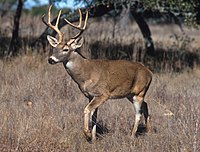
A spatial theory for emergent multiple predator–prey interactions in food webs
Sign Up to like & getrecommendations! Published in 2017 at "Ecology and Evolution"
DOI: 10.1002/ece3.3250
Abstract: Abstract Predator–prey interaction is inherently spatial because animals move through landscapes to search for and consume food resources and to avoid being consumed by other species. The spatial nature of species interactions necessitates integrating spatial… read more here.
Keywords: predator prey; multiple predator; emergent multiple; predator ... See more keywords

Reversed predator–prey cycles are driven by the amplitude of prey oscillations
Sign Up to like & getrecommendations! Published in 2018 at "Ecology and Evolution"
DOI: 10.1002/ece3.4184
Abstract: Abstract Ecoevolutionary feedbacks in predator–prey systems have been shown to qualitatively alter predator–prey dynamics. As a striking example, defense–offense coevolution can reverse predator–prey cycles, so predator peaks precede prey peaks rather than vice versa. However,… read more here.
Keywords: prey; predator prey; prey biomass; reversed cycles ... See more keywords

Community size structure varies with predator–prey size relationships and temperature across Australian reefs
Sign Up to like & getrecommendations! Published in 2022 at "Ecology and Evolution"
DOI: 10.1002/ece3.8789
Abstract: Abstract Climate change and fisheries exploitation are dramatically changing the abundances, species composition, and size spectra of fish communities. We explore whether variation in ‘abundance size spectra’, a widely studied ecosystem feature, is influenced by… read more here.
Keywords: community; community size; reefs; temperature ... See more keywords

Inferring predator–prey interactions from camera traps: A Bayesian co‐abundance modeling approach
Sign Up to like & getrecommendations! Published in 2022 at "Ecology and Evolution"
DOI: 10.1002/ece3.9627
Abstract: Abstract Predator–prey dynamics are a fundamental part of ecology, but directly studying interactions has proven difficult. The proliferation of camera trapping has enabled the collection of large datasets on wildlife, but researchers face hurdles inferring… read more here.
Keywords: ecology; camera; abundance; prey interactions ... See more keywords

Predator, prey, and substrate interactions: the role of faunal activity and substrate characteristics
Sign Up to like & getrecommendations! Published in 2019 at "Ecosphere"
DOI: 10.1002/ecs2.2545
Abstract: Many taxa possess a range of strategies to reduce the risk of predation, including actively seeking suitable refuge habitats; however, the global spread of invasive species may disrupt these behavioral responses. In lotic ecosystems, interstitial… read more here.
Keywords: activity; fine sediment; predator prey; sand ... See more keywords

Habitat complexity mediates the predator-prey space race.
Sign Up to like & getrecommendations! Published in 2019 at "Ecology"
DOI: 10.1002/ecy.2724
Abstract: The spatial relationship between predator and prey is often conceptualized as a behavioral response race, in which prey avoid predators while predators track prey. Limiting habitat types can create spatial anchors for prey or predators,… read more here.
Keywords: predator; predator prey; space race; habitat ... See more keywords

Where and when to hunt? Decomposing predation success of an ambush carnivore.
Sign Up to like & getrecommendations! Published in 2020 at "Ecology"
DOI: 10.1002/ecy.3172
Abstract: Predator-prey games emerge when predators and prey dynamically respond to the behavior of one another, driving the outcomes of predator-prey interactions. Predation success is a function of the combined probabilities of encountering and capturing prey,… read more here.
Keywords: predator prey; temporal spatial; predation; predation success ... See more keywords

Temperature and nutrient conditions modify the effects of phenological shifts in predator-prey communities.
Sign Up to like & getrecommendations! Published in 2022 at "Ecology"
DOI: 10.1002/ecy.3704
Abstract: While there is mounting evidence indicating that the relative timing of predator and prey phenologies shapes the outcome of trophic interactions, we still lack a comprehensive understanding of how important the environmental context (e.g. abiotic… read more here.
Keywords: effects phenological; environmental conditions; predator; phenological shifts ... See more keywords

Differences in prey availability across space and time lead to interaction rewiring and reshape a predator-prey metaweb.
Sign Up to like & getrecommendations! Published in 2022 at "Ecology"
DOI: 10.1002/ecy.3716
Abstract: Space and time promote variation in network structure by affecting the likelihood of potential interactions. However, little is known about the relative roles of ecological and biogeographical processes in determining how species interactions vary across… read more here.
Keywords: interaction; prey availability; space time; interaction rewiring ... See more keywords

A phenology of fear: Investigating scale and seasonality in predator-prey games between wolves and white-tailed deer.
Sign Up to like & getrecommendations! Published in 2023 at "Ecology"
DOI: 10.1002/ecy.4019
Abstract: Predators and prey engage in games where each player must counter the moves of the other, and these games include multiple phases operating at different spatiotemporal scales. Recent work has highlighted potential issues related to… read more here.
Keywords: white tailed; tailed deer; phenology; predator ... See more keywords

Zero-Hopf bifurcation in the Volterra-Gause system of predator-prey type
Sign Up to like & getrecommendations! Published in 2017 at "Mathematical Methods in The Applied Sciences"
DOI: 10.1002/mma.4569
Abstract: We prove that the Volterra-Gause system of predator-prey type exhibits 2 kinds of zero-Hopf bifurcations for convenient values of their parameters. In the first, 1 periodic solution bifurcates from a zero-Hopf equilibrium, and in the… read more here.
Keywords: volterra gause; predator prey; prey type; gause system ... See more keywords